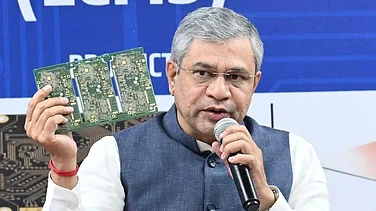There could be some measures aimed at boosting consumption in the upcoming Union Budget, thanks to the bumper dividend payout of Rs 1 lakh crore from the Reserve Bank of India (RBI). This would help the Centre win back middle-class voters, according to T.T. Ram Mohan, economist and former part-time member of Prime Minister Narendra Modi's economic advisory council.
In an exclusive interview with Outlook Business, Mohan said, "Winning back middle-class voters who seem to have defected to the opposition in the recent general elections will certainly be an objective."
The Budget will be presented on July 23 by Finance Minister Nirmala Sitharaman.
Besides his expectations from the budget, the economist also shared his views on pending economic reforms and fresh developments related to the central bank of India.
Edited Excerpts:
We have seen the Union Budget remain fiscally conservative in the recent times, with a great thrust on infrastructure development and building manufacturing capacities. Do you think the new government will follow this similar theme, or a change of plan might be incoming with some consumption side measures?
Broadly, yes, one can expect the government to continue in the same direction. The government will affirm the fiscal deficit target of 5.1 per cent set in the Interim Budget, which is a significant improvement over the revised estimate of 5.8 per cent estimate for 2023-24. However, since the government has an extra Rs 1 lakh crore or so to play with, thanks to the bumper dividend payout from RBI, we may expect some minor tax concessions aimed at boosting consumption, along with more handouts and welfare allocations.
Winning back middle-class voters who seem to have defected to the opposition in the recent general elections will certainly be an objective. The big question is whether the government plans to revive the Old Pension Scheme in some form, without going back to the scheme in its entirety.
The focus on PLI (production-linked incentive) may be expected to continue. The government may want to set up an Office of Independent Audit which will provide timely assessments of where PLI is working, where it is not and what corrective steps need to be taken.
After a long time, S&P has finally revised India’s outlook to ‘positive’ from ‘stable’ citing robust growth and improvement in the quality of public spending. But still, has not changed the ratings yet. Should India have a better demarcation of ‘freebies’ and ‘welfare’ going ahead, to maintain this fiscal discipline given its democratic nature?
The distinction between 'freebies’ and ‘welfare’ is quite artificial. The notion that freebies or cash handouts do not contribute to welfare in the way spending on health or education does is misplaced. It is just that, with many freebies, the welfare dimensions are not obvious to all.
To put it differently, politicians may have a better handle on the welfare impact of freebies than armchair analysts. The legendary Mid-Day meal scheme of MGR (M.G. Ramachandran) in Tamil Nadu, we now know, was not just about better nutrition for children, it also induced greater attendance at school with its corollary benefits. Giving cycles to girls or women may bring about better participation of women in the labour force. Gold chains for families with a girl to marry off may be about reducing dependence on money-lenders.
It would be unwise to dismiss cash benefits or benefits in kind entirely as bribes for voters. There is very often a welfarist connotation to such handouts that are not visible to the commentariat but which politicians are able to discern.
Which key reforms should be part of the new government’s agenda for the next five years to complement and take ahead the policies implemented in the last 10 years? There is already a list of long-pending agendas including land and labor reforms. Should they be given top priority?
The items you mention, along with others such as aggressive privatisation, reaching the FRBM (Fiscal Responsibility and Budget Management) target of 3 per cent for the fiscal deficit have been pending for decades now! No government has been able to deliver on these reforms. All political parties are sensitive to the fact that such reforms do not have the necessary acceptance in our system, so they do not have the incentive to push through these so-called reforms.
There is an important change in the macroeconomic situation that we need to take note of. It does appear that we seem to have moved to a trajectory of growth with macroeconomic stability that is quite comfortable. There is a consensus that India can grow at 6.5-7 per cent over the next ten years. Mind you, this is happening in an international environment that is adverse - global growth rates are below the trend of the past two decades.
More recently, the RBI has been hinting at the possibility of the growth rate rising above this range in the future although it has not made clear what the time horizon for such an acceleration is. Moreover, the recent elections have brought to the fore issues of inequality and ensuring equity. Against this background, issues of distribution are likely to be given more weight relative to the question of accelerating growth through reforms that would impose significant political costs.
If the fiscal deficit and inflation are coming under control; if foreign exchange reserves are poised to stay healthy; if the gross capital formation rate is around 33 per cent of GDP (gross domestic product); and if the economy has grown at over 7 per cent for three years and is likely to do so for the fourth year as well, the impulse to go in for contentious reforms is bound to weaken. Analysts and commentators, who were saying that growth of over 6 per cent is not possible without a slew of 'second-generation' reforms, have some explaining to do.
There seems to be a division of thoughts among the members of RBI’s monetary policy committee regarding the rate cuts. What do you think about this current cross-road of growth and inflation, and how much of a boost can the rate cuts provide to India’s growth when consumption and demand in the country are still reviving?
It is hard to make out a case for a rate cut when GDP is growing at over 7 per cent under such difficult conditions. The majority on the MPC would like to use the opportunity to nudge inflation to as close to 4 per cent.
There are two factors that are relevant. One is that geopolitical risks remain high although they have not spiralled out of control in the past two years. Policy-making must take into account the probability, however low at this point, that a crisis in either Ukraine or the Middle East can be destabilising to global prices in a big way. The second factor is the US Fed’s (Federal Reserve) reluctance to lower its policy rate, something that has a bearing on our exchange rate and on exchange rate stability.
Differences of opinion on such matters are legitimate but it is hard to fault the majority on the MPC for the stance they have taken.
What are your thoughts on the recent guidelines by the RBI on project financing? Finance Ministry has spent a huge amount after pandemic to crowd in private investment; however, economists believe such caution from the central bank could slow down the investment cycle. Can this be over-caution, or RBI is seeing a larger picture here?
The RBI has a very good view of the build-up or risks at the level of individual banks and at the aggregate level. We cannot ignore the fact that the crisis in the banking system from which we have just emerged after nearly a decade of stress was caused primarily by lending to infrastructure, much of it project finance.
While private investment in infrastructure is bound to be impacted by the proposed norms (these are yet to be finalised), government is at liberty to continue its funding via the budget. We can count on the RBI to arrive at a proper view after taking into account all concerns.
Indian bonds are being included in the JP Morgan Emerging Markets Bond Index, a development that is supposed to increase the country’s exposure to global investors and foreign capital. What do you think should be the way forward for the RBI in terms of managing the Rupee? Economists for a good time have already been divided between the free-float and managed-float stance. What do you think of this debate once our exposure becomes wider?
This is one issue on which there should be no ambiguity after three decades of reforms in India. The policy of managed-float has served us well and it is also the policy that other countries, who preached free-float, are now practising. We cannot afford huge swings in the exchange rate and we wish to preserve independence in monetary policy. Managed-float will be the way forward in the near future.



























